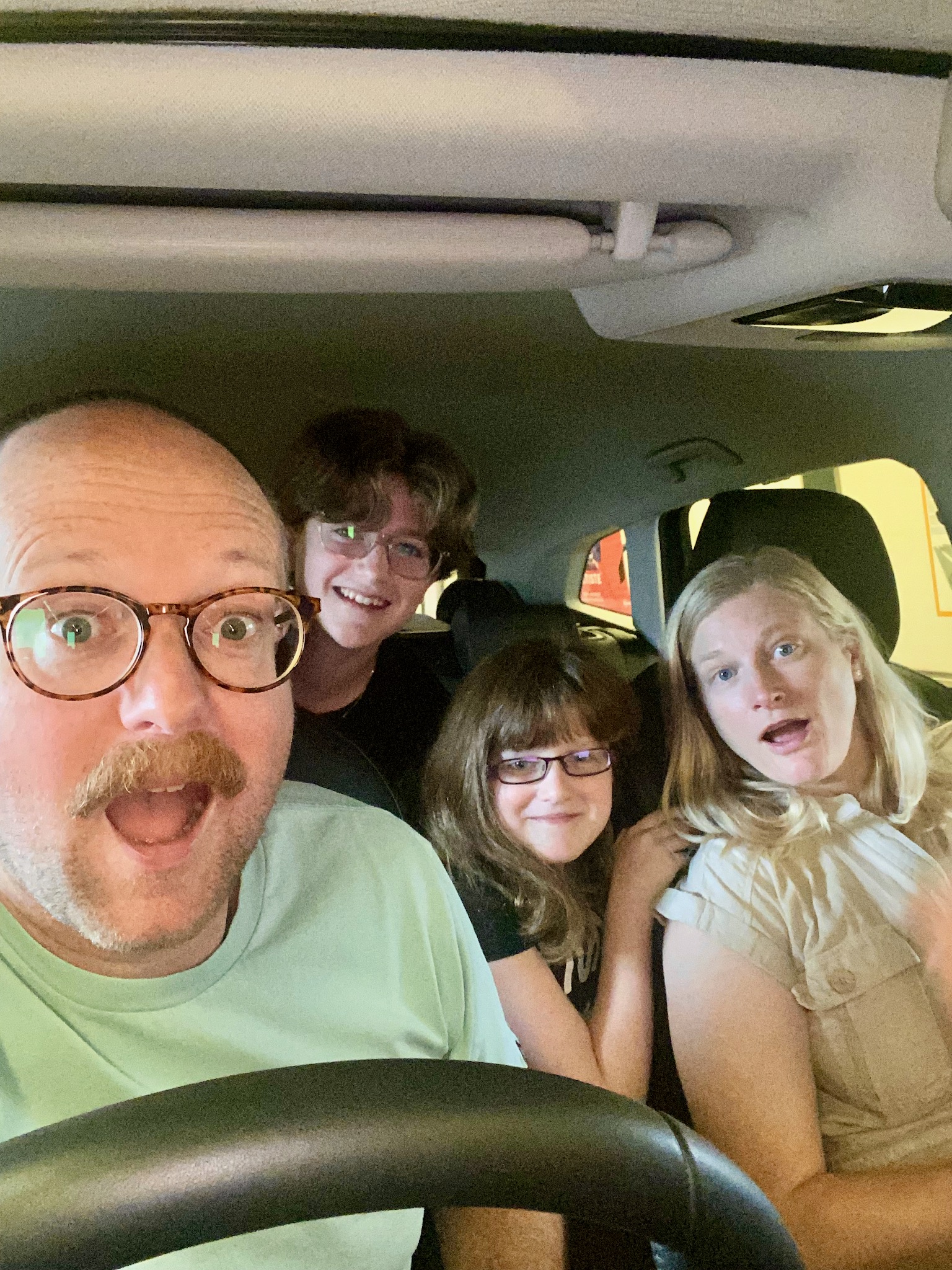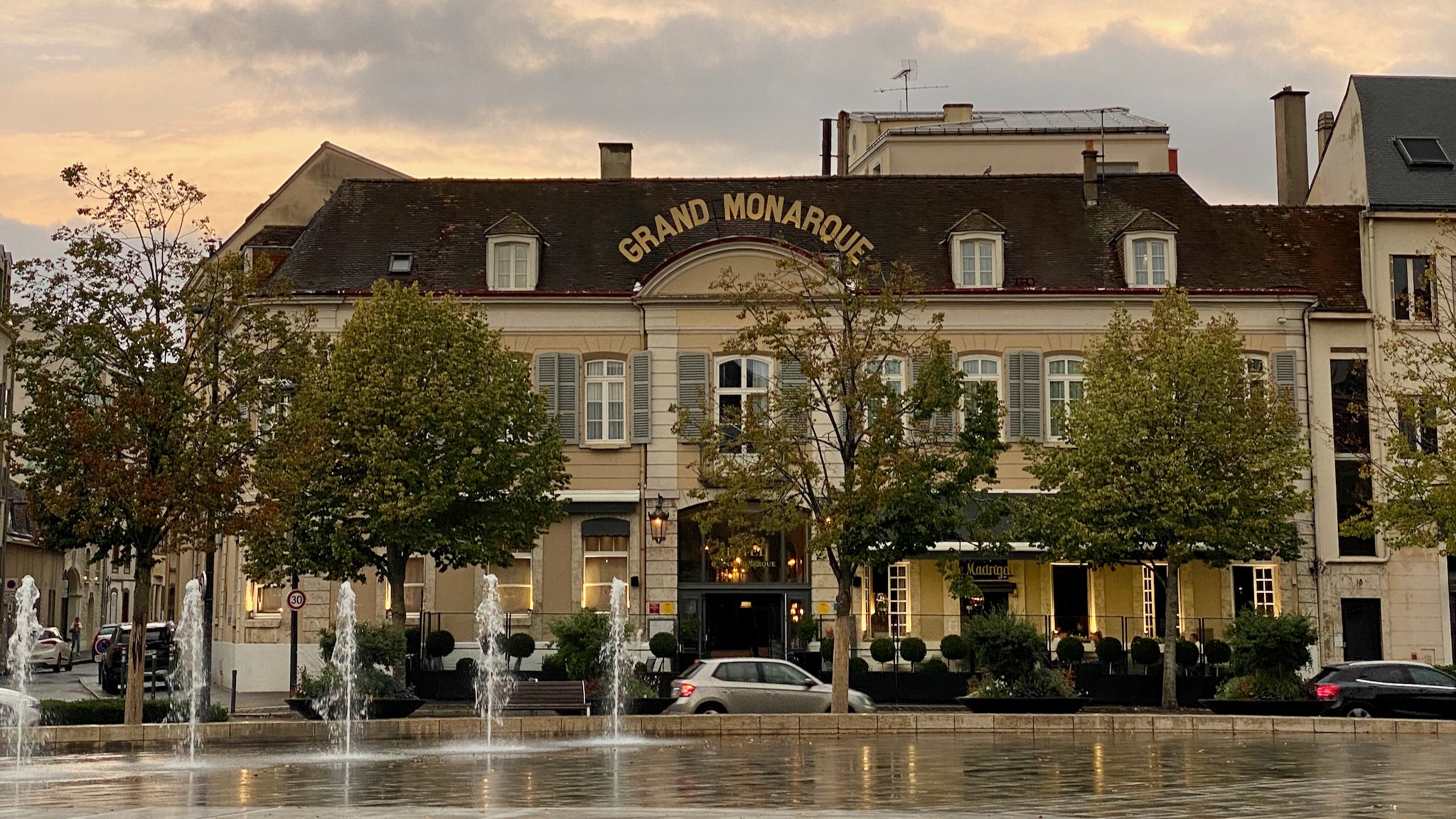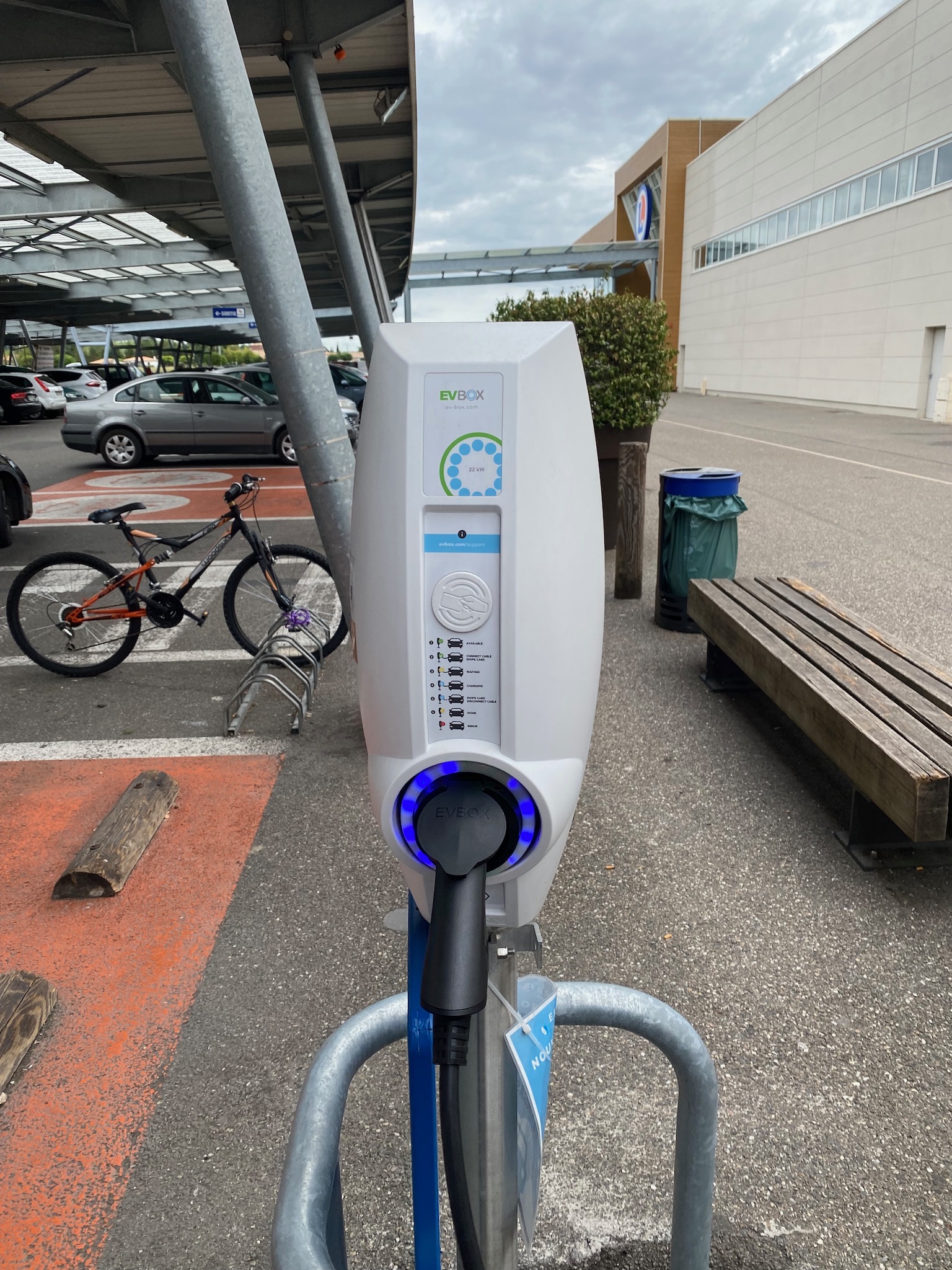anthony galvin
TAGGED: CARS
Charging to the Dordogne (and back)
Thursday afternoon and in between the last few work calls of the day we throw in a few bags and the inflatable paddle board then head south. Our first stop is going to be Folkestone, but our goal is to arrive at our gîte for the week near Bergerac, in South West France.
Getting There (Northamptonshire - Folkestone - Chartres - Bergerac)

As well as packing for this trip we have an additional consideration. Charging. This is going to be our longest trip in the Enyaq so far, a 1500 mile round trip. We are setting off with a fully charged battery (or about 270 miles of motorway driving) so the main concern on the trip down to Folkestone from Northamptonshire isn't range, but the usual M25 chaos and rush hour traffic.
Our 'Le Shuttle' isn't until the next morning, with an overnight in the squarely functional Holiday Inn Express near the terminal. But to make sure we can set off with a full battery again in the morning we stop off at Folkestone services for a top-up charge and some dinner. The Ionity fast charger isn't in the main part of the services, but located by the petrol station. We park up, plug-in and tap our Electroverse card and then make our way back along the exit road to the services, which isn't as straightforward as it could be.
It's only 7pm when we get there, but already most of the food options have already closed, so there's only a packed McDonalds for dinner. Not quite the culinary start we'd hoped for, but hopefully a contrast with the better things to come.
After a night at the Holiday Inn Express we nip over to the Eurotunnel and manage to get on a slightly earlier shuttle. Before we know it we are on the French autoroute and heading along the rolling toll roads of Normandy.

We are firmly committed to using the Route Anglais, even signing up to a 'blip and go' tag so that we can use the fast lane at the Peage. It's only when we arrive at the first toll gate do we realise that I've stuck the 'dongle' on the wrong side of the car, meaning Emma has to unclip it and wave it at the invisible gatekeeper as we drive up to the barrier!
Our first stop is the Aire de la Baie de Somme, for a quick charge to top up (30 mins and a terrible service station coffee) before heading into Saint-Vallery-sur-Somme for a fantastic lunch, ice-cream and leg stretch. It's a lovely French sea-side town and it's hard to drag ourselves away, but we've got to push on to our overnight stop-off in Chartres.
The toll roads are suitably clear and after a few hours and some more 'dongle waving' we make it to Chartres for late afternoon. There's a street charger that allows 2 hours slow charging just round the corner from our hotel - the slightly decadent Hotel Le Grand Monarque - so we take the free juice before moving the car to the car park and then exploring the old town. The highlight of the evening being the amazing projection mapping show that turns the towering cathedral into a canvas.

The next morning, after a leisurely breakfast, there's the dawning realisation that we've still got a lot of kilometres to cover. It's another day of Ionity charging with a couple of stops, including the slightly sparse Rue Henri Becquerel. Which is just a row of chargers in a car park near the motorway - no toilets or refreshments available. The Saturday traffic isn't great and it takes 6 hours driving and nearly two hours charging to make or to our gîte west of Bergerac. The temperature is in the low 30s which is great for the battery efficiency, but also means we have the aircon cranking the whole day.
750 miles after we set-off from Northamptonshire, we arrive at our home for the week. A little tired, but happy and ready to hit the pool!

Over the next week we don't head too far. Most of the week is spent in the pool, eating cheese or canoeing and paddle boarding along the river.
There's still some pottering about and from time-to-time we do need to top up. This is a little hit and miss. Every little town and village in the Dordogne has a charger, usually in the town square or near the Marie. However, the first time we try and get one to work with our Electroverse card nothing happens. The same is also true with the chargers at the local Leclerc - I did try and get to the bottom of this with someone on the desk at the supermarket, but my GCSE French doesn't run to the intricacies of the different charging networks, so in the end we plug-in the granny gable overnight.

Once we've download the local charging app we manage to get up and running in the car park in Beynac. It's not clear if the problem was with the RFID card, our network or the local provider, but the lesson here is if in doubt also try the local networks own app.
Heading Home (Bergerac - Paris - Calais - Northamptonshire)
The last Saturday in August is not the day to be hitting the French roads. Once we get away from our quiet rural corner and starting heading north it very quickly becomes apparent that the roads are going to be busy. Thanks to the granny cable, we are setting off fully charged, but we still have to top up a couple of times on our way to Paris.
As we pull off the motorway for our first stop, it's clear the service station is at capacity, with people parked on the grass and a queue spilling out of the toilets into the car park. Somehow though there's a spare Ionity available and we can charge up whilst we grab some lunch. By the time we've had something to eat there's a queue of cars waiting to charge. It's a short stop for us, but that's more down to luck than judgement. We push on trying to get to Paris in time to enjoy our evening (with a trip up the Eiffel Tower already booked in). Our 2nd stop is slightly less successful - there's a bit of a queue and we spend half an hour waiting before we can start to charge up. We crawl into Paris and find the entrance to our underground car park.
We squeeze our way into the Q-Park Rivoli Pont Neuf, near Les Halles, and are delighted to discover a bank of empty chargers at the far end of the car park. This wasn't a planned charge, but as we are leaving the car overnight anyway, it's ideal and we plugin and head off to check-in to the Novotel Les Halles. The hotel is in a great spot, in the 'new Les Halles' - much nicer than I remember it being 20 or so years ago. The parking is fairly good value if you're staying at the hotel, and the charging is also reasonably priced.

After a morning wandering round the Louvre, some shopping on the Rue de Rivoli and long lazy lunch at Nelsons we get ready for the final leg of our journey. Fully charged we don't need to stop on the way to Calais.
We arrive a little early and nip up to the Ionity chargers that are located at the Holiday Inn just a few minutes from the Eurotunnel terminal. In hindsight we shouldn't have bothered and should have gone straight to the terminal and charged up there. Due to some unexplained delays all the trains are out of sync and there would have been plenty of time to queue up and top-up at the chargers in the Eurotunnel carpark.
After a couple of hours waiting we make it onto a shuttle and the final part of our 1500 mile journey, heading round the M25 and up the M1 to make it home in a single hit.
Would we do it again?
A 1500 mile road trip is always going to take some time, and having to queue and charge probably did add a little bit of extra time to our overall journey. At most of the charging spots we stopped at we didn't need to queue for more than a few minutes, if at all, and we were travelling on some pretty busy days in the holiday season.
The prevalence of the Ionity chargers certainly makes travelling long distances easier (there's over 100 Ionity locations in France). Overall we spent about £200 on charging £70 on tolls. Driving isn't going to be as time efficient as flying or getting the train, but it does allow you to stop off. We probably wouldn't have had such great visits to Chartres and Paris if we hadn't driven (though we also stopped off in Folkestone, so it's not all gravy). In terms of the environmental impact, flying would release about 700KG of CO2, whilst driving our EV is about 145kg so as well as being more enjoyable it's better for the planet (with all the caveats that driving hundreds of miles for a holiday is never going to be 'good' for the environment).
Would we do another EV road trip through France? Well yes, we are already planning a trip to the Alps at Easter!
19/09/2022 permalink
Self-driving cars: moonshot or beer wagon?
Almost every day there’s some new buzz, hype and occasional factual statement about self driving cars. The intersection (pun intended) of technology, user experience and transport policy is an interesting place.
From a technology perspective it feels like autonomous vehicles could be the equivalent of the space race for our times. As a side effect of getting people on the moon, NASA is also credited with inventing everything from Nike Air to better dentistry. Whilst the self-driving car industry is still in its infancy, innovations in detailed mapping, artificial intelligence, motion detection, capacity planning, battery technology and machine learning (to name but a few) have already started to have a significant impact on the technology we use everyday.
But transport and mobility matter a lot more than as a way to get a more accurate vacuum cleaner. The relationship people have with cars is complicated. Much of what has been written about vehicle ownership, usage and urban planning doesn’t take into account the irrational choices that people make around transport everyday. How autonomous vehicles fit into real world scenarios is going to be complicated, and based on how politicians handle most rapid technology change, I’m not optimistic about how smoothly the polity will adapt.
In many ways the motor car has been one of the most liberating inventions of the past 150 years. If I was so inclined, tomorrow morning I could pile up the car and drive to the South of France (or more likely the west coast of Scotland) with a level of ease and freedom not possible 100 years or so ago. Yet, despite having a car I don’t really self identify as a driver. It’s something I do, but I’m more likely to say I’m a cyclist or walker. But I’m conscious for many people driving is a very important part of their identify, and for some people the self-driving car represents a challenge to the idea of what it means to be human.
As with most complex technology problems, it’s easier to get to grips with them if you start by trying to build your own version. A self-driving car is a bit of a leap, but the next step for the location aware drinks trolley I build last year is probably autonomy. Even if I don’t get as far as a universal product, a beer wagon that can navigate my office is probably a pretty good place to start.
2017-01-30 22:28:23 GMT permalink